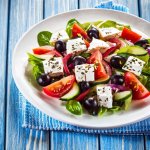I have noticed when watching traditional Greeks cook, they very rarely have a recipe out. They're simply putting together the recipes. This is especially true for savory cooking. I have a friend who makes cheese pita completely off the top of her head, and each time she makes it, she seems to use slightly different combinations of cheeses, depending on what she can find and what she has on hand. I have seen this with other dishes, as well.
Does anyone have any advice how I can learn to cook this way? Thanks! I know, it might be hard to explain, but I want to develop an "intuition" in the kitchen that I don't seem to have. I always need a recipe.
Does anyone have any advice how I can learn to cook this way? Thanks! I know, it might be hard to explain, but I want to develop an "intuition" in the kitchen that I don't seem to have. I always need a recipe.




